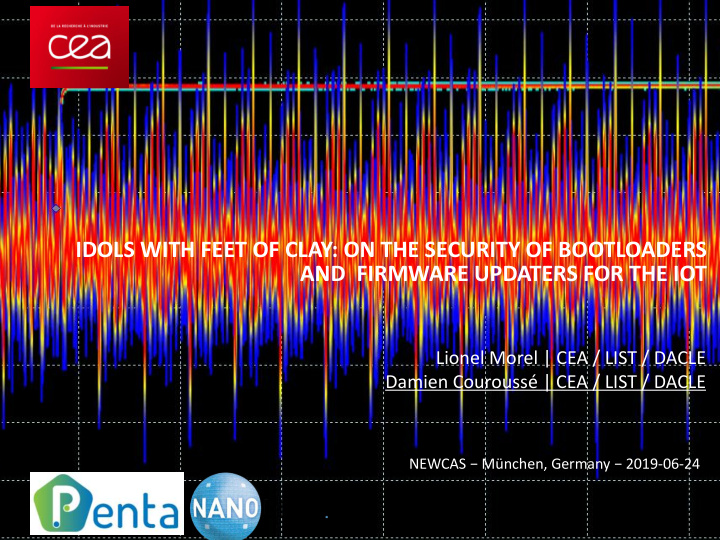



IDOLS WITH FEET OF CLAY: ON THE SECURITY OF BOOTLOADERS AND FIRMWARE UPDATERS FOR THE IOT Lionel Morel | CEA / LIST / DACLE Damien Couroussé | CEA / LIST / DACLE NEWCAS − München, Germany − 2019 -06-24
BFUs − BOOTLOADERS AND FIRMWARE UPDATERS Bootloader ? • Everything that is between the system reset/startup and the startup of the ‘User Application’. • Also supports the capability to upgrade parts or all of its firmware • The bootloader component may not be included in this understanding of firmware • Achille’s heel of the whole system: if you control the boot process or the upgrade process, you control the world platform. Security properties to support • encryption functions, usually symmetric Confidentiality • Integrity • requires hardware support (“ anti tampering ”) Of the device • CRC, hash functions, MAC, digital signature Of the firmare • MAC, digital signature Authenticity Our credo: BFUs provide a good case to study the security of Embedded/IoT systems • Logical security: exploits of buffer overflows, ROPs, memory dumps, etc. • Hardware security, mainly side-channel and fault-injection attacks, reverse engineering • BFUs integrate cryptography • But you can target all the glue code around the crypto components! • A good case study to demonstrate the scalability of analysis tools NEWCAS 2019 | 2
GENERIC ARCHITECTURE OF A BFU Cryptographic functions : implemented in SW, dedicated HW IPs, or SW+specific processor instructions “System” components : implemented in SW, mostly HW-dependant and/or supported by dedicated HW (e.g. DMA for data movement) Control logic : implemented in SW NEWCAS 2019 | 3
PHYSICAL ATTACKS A major threat against secure embedded systems side channel fault injection • The most effective attacks against crypto-systems attacks attacks • Relevant against many parts of CPS/IoT: bootloaders, firmware upgrade, etc. • Recently used to leverage software vulnerabilities [1] In practice, • An attacker mostly uses logical attacks if the target is unprotected (e.g. typical IoT devices): buffer overflows, ROP, protocol vulnerabilities, etc. • All high security products embed countermeasures against side-channel and fault injection attacks. E.g. Smart Cards, payTV, military-grade devices. • Using a combination of hardware and software [1] A. Cui and R. Housley , ‘BADFET: countermeasures • Defeating Modern Secure Boot Using Tools for Side-channel and fault injection are getting Second-Order Pulsed Electromagnetic really affordable Fault Injection’, presented at the WOOT, 2017. NEWCAS 2019 | 4
EXPLOITATION OF SIDE-CHANNEL INFORMATION LEAKAGE Simple power analysis (SPA) SPA leaks from an RSA implementation P . Kocher, J. Jaffe, B. Jun, and P. Rohatgi, ‘Introduction to differential power analysis’, Journal of Cryptographic Engineering, vol. 1, no. 1, pp. 5 – 27, 2011. Correlation Power/EM Analysis (CPA/CEMA) – Can be generalised to any physical observation of the secured computation • AES, unprotected implementation • Key found! EM traces • Attack on the output of the 1 st SBOX After the encryption of 4240 Bytes of data! NEWCAS 2019 | 5
EXPLOITATION OF SIDE-CHANNEL INFORMATION LEAKAGE Simple power analysis (SPA) SPA leaks from an RSA implementation P . Kocher, J. Jaffe, B. Jun, and P. Rohatgi, ‘Introduction to differential power analysis’, Journal of Cryptographic Engineering, vol. 1, no. 1, pp. 5 – 27, 2011. Correlation Power Analysis (CPA) – Can be generalised to any physical observation of Correlation Power/EM Analysis (CPA/CEMA) – Can be generalised to the secured computation any physical observation of the secured computation Secondary leakages, at almost every CPU cycle! Main leakage: memory read of SBOX[m k] Key found! • AES, unprotected implementation • AES, unprotected implementation • EM traces • EM traces • Attack on the output of the 1 st SBOX • Attack on the output of the 1 st SBOX NEWCAS 2019 | 6
SIDE-CHANNEL ATTACKS: APPLICATION TO BFUS 1. Inspection of single side-channel traces • Reverse-engineering, e.g., identification of the program structure 2. CPA/CEMA • Recovery of secret data, e.g. cipher keys • Reverse-engineering of lookup tables NEWCAS 2019 | 7
FAULT INJECTION ATTACKS: APPLICATION TO BFUS Fault models, at the Instruction Set Architecture (ISA) level: 1. Data alteration, down to the bit level. • ROM / RAM, processor registers • Bit flip, bit stuck-at • Typically: modification of loop counters, crypto data, opcode corruption. 2. Instruction skip, instruction modification • Typically: NOP execution, arbitrary jumps [1] 3. Modification of the control flow, [1] I. Polian, M. Joye, I. Verbauwhede, M. Witteman, and J. e.g., test inversion Heyszl, ‘Controlled fault injection: wishful thinking, thoughtful engineering or just luck ?’, FDTC, 2017. NEWCAS 2019 | 8
SECURED BOOTLOADERS IoT security: 2 types of product families 1. Integrates AES-256 clearly not enough 2. Secured bootloaders Atmel, MicroChip, STMicroelectronics, etc. Secured bootloader: provides a secured Chain-of- Trust (CoT) encompassing a full boot sequence. • The SW boot component can be considered as part of the product. Immutable in memory, usually not upgradable. • Provides a Secure Enclave • Secured storage with limited capacity. Usually only for a few encryption keys. Example: X-CUBE-SBSFU • Secured execution context with limited processing capability Many interesting initiatives in the • Strong isolation from the User / Application RISC-V ecosystem. execution domain. • • Only the User/Client app is upgradable e.g. wolfBoot • Does not protect the User Application. i.e., securing the https://www.wolfssl.com/products/wolf User / Application execution domain is still up to the boot application developer NEWCAS 2019 | 9
IDOLS WITH FEET OF CLAY: ON THE SECURITY OF BOOTLOADERS AND FIRMWARE UPDATERS FOR THE IOT Lionel Morel | CEA / LIST / DACLE Damien Couroussé | CEA / LIST / DACLE damien.courousse@cea.fr Centre de Saclay Centre de Grenoble 17 rue des Martyrs Nano-Innov PC 172 91191 Gif sur Yvette Cedex 38054 Grenoble Cedex
Recommend
More recommend